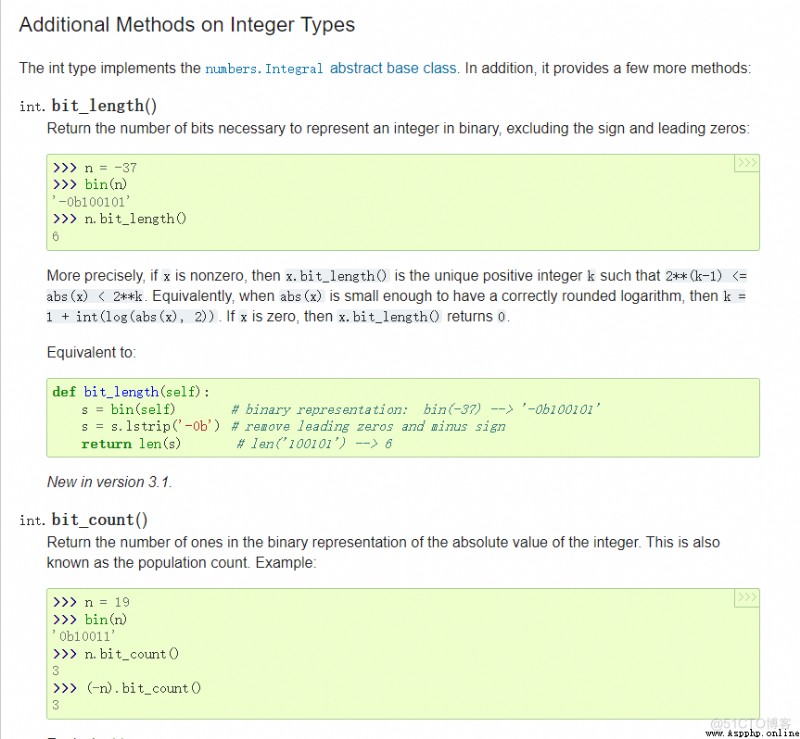
如果您使用 Python 進行過任何編碼,那麼您很有可能在某個程序中使用了數字。例如,您可能使用整數來指定列表中值的索引。 但是 Python 中的數字不僅僅是它們的原始值。讓我們看看你可能不知道的關於 Python 中數字的三件事。
Python 中有個概念叫做:一切皆對象。您在 Python 中學習的第一個對象 "HelloWorld" 是表示字符串的 str 對象。
然後你學習了字符串有方法,例如 .lower() 方法,它返回一個全小寫字符的新字符串:
>>> "HELLO". lower()
'hello'
比如首字母大寫 capitalize(), 返回字符串的副本,其第一個字符大寫,其余小寫。
>>> mystring = "hello python"
>>> print( mystring. capitalize())
Hello python
Python 中的數字也是對象,就像字符串一樣,也有自己的方法。例如,您可以使用 .to_bytes() 方法:
>>> n = 255
>>> n. to_bytes( length = 2, byteorder = "big")
b'\x00\xff'
其中,length 參數指定了要在字符串中使用的字節數,byteorder 參數確定字節的順序。例如,將 byteorder 設置為 “big”會返回一個字節字符串,其中最重要的字節在前,而將 byteorder 設置為 "little" 則將最不重要的字節放在最前面。
>>> n. to_bytes( length = 2, byteorder = "little")
b'\xff\x00'
255 是可以表示為 8 位整數的最大整數,因此您可以在 .to_bytes() 中設置 length=1 也沒有問題:
>>> n. to_bytes( length = 1, byteorder = "big")
b'\xff'
但是,如果在 .to_bytes() 中將 length=1 設置為 256,則會收到 OverflowError 錯誤:
>>> n = 256
>>> n. to_bytes( length = 1, byteorder = "big")
Traceback ( most recent call last):
File "<stdin>", line 1, in < module >
OverflowError: int too big to convert
您可以使用 .from_bytes() 類方法將字節字符串轉換為整數:
>>> int. from_bytes( b'\x06\xc1', byteorder = "big")
1729
類方法是從類名而不是類實例調用的,這就是在上面的 int 上調用 .from_bytes() 方法的原因。
浮點數也有方法。也許對浮點數最有用的方法是 .is_integer() ,它用於檢查浮點數是否沒有小數部分:
>>> n = 2.0
>>> n. is_integer()
True
>>> n = 3.14
>>> n. is_integer()
False
一種有趣的浮點方法是 .as_integer_ratio() 方法,它返回一個元組,其中包含表示浮點值的分數的分子和分母:
>>> n = 0.75
>>> n. as_integer_ratio()
( 3, 4)
但是,由於 浮點表示錯誤,此方法可能會返回一些意外值:
>>> n = 0.1
>>> n. as_integer_ratio()
( 3602879701896397, 36028797018963968)
如果需要,您可以通過用括號括住文字來調用數字類型上的方法:
>>> ( 255). to_bytes( length = 1, byteorder = "big")
b'\xff'
>>> ( 3.14). is_integer()
False
如果你沒有用括號括起整數文字,當你調用一個方法時你會看到一個 SyntaxError ——盡管奇怪的是,你不需要帶有浮點文字的括號:
>>> 255. to_bytes( length = 1, byteorder = "big")
File "<stdin>", line 1
255. to_bytes( length = 1, byteorder = "big")
^
SyntaxError: invalid syntax
>>> 3.14. is_integer()
False
您可以在 文檔中找到 Python 數字類型可用方法的完整列表:

在數學中,數字具有自然的層次結構。例如,所有自然數都是整數,所有整數都是有理數,所有有理數都是實數,所有實數都是復數。 Python 中的數字也是如此。這個“數字塔”通過 numbers 模塊來表示。
Python 中的每個數字都是 Number 類的一個實例:
>>> from numbers import Number
>>> # Integers inherit from Number
>>> isinstance( 1729, Number)
True
>>> # Floats inherit from Number
>>> isinstance( 3.14, Number)
True
>>> # Complex numbers inherit from Number
>>> isinstance( 1j, Number)
True
如果您需要檢查 Python 中的值是否為數字,但您不關心該值是什麼類型的數字,請使用 isinstance(value, Number)。
Python 附帶了四種額外的抽象類型,其層次結構從最通用的數字類型開始,如下所示:
complex。float。Fraction。int 和bool。你可以在你的終端中驗證所有這些:
>>> import numbers
>>> # Complex numbers inherit from Complex
>>> isinstance( 1j, numbers. Complex)
True
>>> # Complex numbers are not Real
>>> isinstance( 1j, numbers. Real)
False
>>> # Floats are Real
>>> isinstance( 3.14, numbers. Real)
True
>>> # Floats are not Rational
>>> isinstance( 3.14, numbers. Rational)
False
>>> # Fractions are Rational
>>> from fractions import Fraction
>>> isinstance( Fraction( 1, 2), numbers. Rational)
True
>>> # Fractions are not Integral
>>> isinstance( Fraction( 1, 2), numbers. Integral)
False
>>> # Ints are Integral
>>> isinstance( 1729, numbers. Integral)
True
>>> # Bools are Integral
>>> isinstance( True, numbers. Integral)
True
>>> True == 1
True
>>> False == 0
True
不過,仔細看看,有幾件事對 Python 的數字層次結構有些怪異。
Python 數字塔中的四種抽象類型對應的具體數值類型有四種:complex, float, Fraction, 和 int.
但是 Python 有第五種數字類型,即 Decimal 類,用於精確表示十進制數並克服浮點運算的限制。
你可能猜到 Decimal 數是實數,但你錯了:
>>> from decimal import Decimal
>>> import numbers
>>> isinstance( Decimal( "3.14159"), numbers. Real)
False
事實上,Decimal 數字繼承自的唯一類型是 Python 的 Number 類:
>>> isinstance( Decimal( "3.14159"), numbers. Complex)
False
>>> isinstance( Decimal( "3.14159"), numbers. Rational)
False
>>> isinstance( Decimal( "3.14159"), numbers. Integral)
False
>>> isinstance( Decimal( "3.14159"), numbers. Number)
True
Decimal 不繼承自 Integral 是有道理的。在某種程度上,Decimal 不繼承自 Rational 也是有道理的。但是為什麼 Decimal 不從 Real 或 Complex 繼承呢?
答案就在 CPython 源代碼中:
Decimal 具有 Real abc 指定的所有方法,但不應將其注冊為 Real,因為小數不與二進制浮點數互操作(例如:*Decimal('3.14') + 2.71828* 是不支持的)。但是,抽象實數預計可以互操作(即,如果 R1 和 R2 都是實數,則 *R1 + R2* 應該可以工作)。
這一切都歸結為實現。
另一方面,浮點數實現了 Real 的抽象基類,並用於表示實數。但是,由於有限的內存約束,浮點數僅僅是實數的有限近似值。這令人困惑,如以下內容:
>>> 0.1 + 0.1 + 0.1 == 0.3
False
浮點數作為二進制分數存儲在內存中,但這會導致一些問題。 就像分數一樣 1/3 沒有有限的十進制表示——小數點後有無數個三。 分數 1/10 沒有有限二進制分數表示。換句話說,你不能以精確的精度將 0.1 存儲在計算機上——除非那台計算機有無限的內存。
從嚴格的數學角度來看,所有浮點數都是有理數——除了 float("inf") 和 float("nan")。但是程序員使用它們來近似實數並將它們在大多數情況下視為實數。
float("nan") 是一個特殊的浮點值,表示“非數字”值——通常縮寫為 NaN 值。但是由於 float 是數字類型,所以 isinstance(float("nan"), Number) 返回 True
沒錯:“不是數字”值是數字。("not a number" values are numbers.)
這就是浮點數的奇怪之處。
Python 的抽象數字基類型允許您創建自己的自定義抽象和具體數字類型。 即利用 Python 中關於數字的類型,比如 numbers 中的類型,可以定義其他有特殊屬性和方法的數字對象。
例如,考慮下面的類 ExtendedInteger,它實現了 a+b \sqrt p 形式的數字,其中 *a* **和 *b* 是整數,p** 是素數(請注意,類不強制素數):
import math
import numbers
class ExtendedInteger( numbers. Real):
def __init__( self, a, b, p = 2) - > None:
self. a = a
self. b = b
self. p = p
self. _val = a + ( b * math. sqrt( p))
def __repr__( self):
return f"{ self. __class__. __name__} ({ self. a} , { self. b} , { self. p} )"
def __str__( self):
return f"{ self. a} + { self. b} √{ self. p} "
def __trunc__( self):
return int( self. _val)
def __float__( self):
return float( self. _val)
def __hash__( self):
return hash( float( self. _val))
def __floor__( self):
return math. floor( self. _val)
def __ceil__( self):
return math. ceil( self. _val)
def __round__( self, ndigits = None):
return round( self. _val, ndigits = ndigits)
def __abs__( self):
return abs( self. _val)
def __floordiv__( self, other):
return self. _val / / other
def __rfloordiv__( self, other):
return other / / self. _val
def __truediv__( self, other):
return self. _val / other
def __rtruediv__( self, other):
return other / self. _val
def __mod__( self, other):
return self. _val % other
def __rmod__( self, other):
return other % self. _val
def __lt__( self, other):
return self. _val < other
def __le__( self, other):
return self. _val <= other
def __eq__( self, other):
return float( self) == float( other)
def __neg__( self):
return ExtendedInteger( - self. a, - self. b, self. p)
def __pos__( self):
return ExtendedInteger( + self. a, + self. b, self. p)
def __add__( self, other):
if isinstance( other, ExtendedInteger):
# If both instances have the same p value,
# return a new ExtendedInteger instance
if self. p == other. p:
new_a = self. a + other. a
new_b = self. b + other. b
return ExtendedInteger( new_a, new_b, self. p)
# Otherwise return a float
else:
return self. _val + other. _val
# If other is integral, add other to self's a value
elif isinstance( other, numbers. Integral):
new_a = self. a + other
return ExtendedInteger( new_a, self. b, self. p)
# If other is real, return a float
elif isinstance( other, numbers. Real):
return self. _val + other. _val
# If other is of unknown type, let other determine
# what to do
else:
return NotImplemented
def __radd__( self, other):
# Addition is commutative so defer to __add__
return self. __add__( other)
def __mul__( self, other):
if isinstance( other, ExtendedInteger):
# If both instances have the same p value,
# return a new ExtendedInteger instance
if self. p == other. p:
new_a = ( self. a * other. a) + ( self. b * other. b * self. p)
new_b = ( self. a * other. b) + ( self. b * other. a)
return ExtendedInteger( new_a, new_b, self. p)
# Otherwise, return a float
else:
return self. _val * other. _val
# If other is integral, multiply self's a and b by other
elif isinstance( other, numbers. Integral):
new_a = self. a * other
new_b = self. b * other
return ExtendedInteger( new_a, new_b, self. p)
# If other is real, return a float
elif isinstance( other, numbers. Real):
return self. _val * other
# If other is of unknown type, let other determine
# what to do
else:
return NotImplemented
def __rmul__( self, other):
# Multiplication is commutative so defer to __mul__
return self. __mul__( other)
def __pow__( self, exponent):
return self. _val < strong > exponent
def __rpow__( self, base):
return base < / strong > self. _val
您需要實現許多 dunder方法以確保具體類型實現 Real 接口。您還必須考慮 .__add__() 和 .__mul__() 等方法如何與其他 Real 類型交互。
實現 ExtendedInteger 後,您現在可以執行以下操作:
>>> a = ExtendedInteger( 1, 2)
>>> b = ExtendedInteger( 2, 3)
>>> a
ExtendedInteger( 1, 2, 2)
>>> # Check that a is a Number
>>> isinstance( a, numbers. Number)
True
>>> # Check that a is Real
>>> isinstance( a, numbers. Real)
True
>>> print( a)
1 + 2 √2
>>> a * b
ExtendedInteger( 14, 7, 2)
>>> print( a * b)
14 + 7 √2
>>> float( a)
3.8284271247461903
Python 的數字層次結構非常靈活。但是,當然,在實現派生自內置抽象基類型的類型時,您應該始終非常小心。你需要確保他們與其他人相處得很好。 在實現自定義數字類型之前,您應該閱讀類型實現者的文檔中 有幾個提示。仔細閱讀 Fraction 的 實現也很有幫助。
所以文章你看完了。關於 Python 中的數字,您可能不知道的三件事(可能還有更多):
Decimal 和float 濫用了一點。我希望你學到了一些新東西! 參考鏈接: